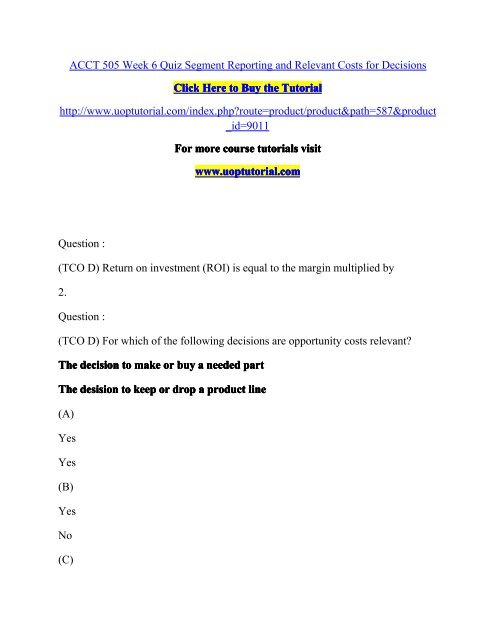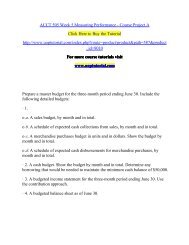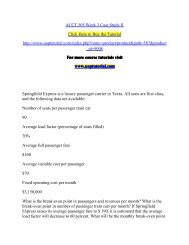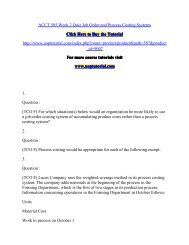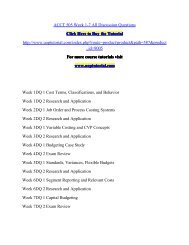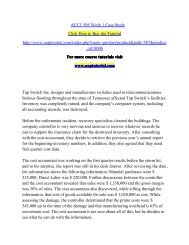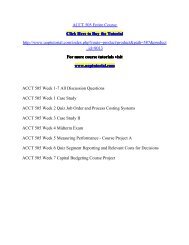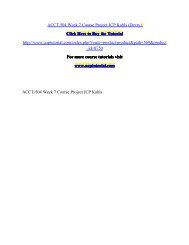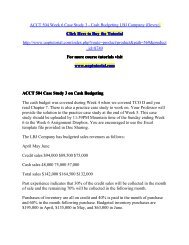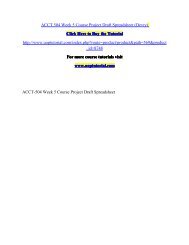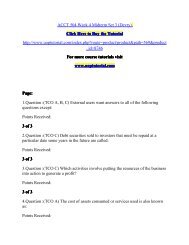ACCT 505 Week 6 Quiz Segment Reporting and Relevant Costs for Decisions
- No tags were found...
You also want an ePaper? Increase the reach of your titles
YUMPU automatically turns print PDFs into web optimized ePapers that Google loves.
<strong>ACCT</strong> <strong>505</strong> <strong>Week</strong> 6 <strong>Quiz</strong> <strong>Segment</strong> <strong>Reporting</strong> <strong>and</strong> <strong>Relevant</strong> <strong>Costs</strong> <strong>for</strong> <strong>Decisions</strong><br />
Click Here to Buy the Tutorial<br />
http://www.uoptutorial.com/index.php?route=product/product&path=587&product<br />
_id=9011<br />
For more course tutorials visit<br />
www.uoptutorial.com<br />
Question :<br />
(TCO D) Return on investment (ROI) is equal to the margin multiplied by<br />
2.<br />
Question :<br />
(TCO D) For which of the following decisions are opportunity costs relevant?<br />
The decision to make or buy a needed part<br />
The desision to keep or drop a product line<br />
(A)<br />
Yes<br />
Yes<br />
(B)<br />
Yes<br />
No<br />
(C)
No<br />
Yes<br />
(D)<br />
No<br />
No<br />
3.<br />
Question :<br />
(TCO D) Last year, the House of Orange had sales of $826,650, net operating<br />
income of $81,000, <strong>and</strong> operating assets of $84,000 at the beginning of the year<br />
<strong>and</strong> $90,000 at the end of the year. What was the company's turnover, rounded to<br />
the nearest tenth?<br />
1.<br />
Question :<br />
(TCO D) Data <strong>for</strong> December concerning Dinnocenzo Corporation's two major<br />
business segments-Fibers <strong>and</strong> Feedstocks-appear below:<br />
Sales revenues, Fibers<br />
$870,000<br />
Sales revenues, Feedstocks<br />
$820,000<br />
Variable expenses, Fibers<br />
$426,000<br />
Variable expenses, Feedstocks<br />
$344,000
Traceable fixed expenses, Fibers<br />
$148,000<br />
Traceable fixed expenses, Feedstocks<br />
S156,000<br />
Common fixed expenses totaled $314,000 <strong>and</strong> were allocated as follows: $129,000<br />
to the Fibers business segment <strong>and</strong> $185,000 to the Feedstocks business segment.<br />
Required:<br />
Prepare a segmented income statement in the contribution <strong>for</strong>mat <strong>for</strong> the company.<br />
Omit percentages; show only dollar amounts.<br />
2.<br />
Question :<br />
(TCO D) Wryski Corporation had net operating income of $150,000 <strong>and</strong> average<br />
operating assets of $500,000. The company requires a return on investment of 19%.<br />
Required:<br />
i. Calculate the company's current return on investment <strong>and</strong> residual income.<br />
ii. The company is investigating an investment of $400,000 in a project that will<br />
generate annual net operating income of $78,000. What is the ROI of the project?<br />
What is the residual income of the project? Should the company invest in this<br />
project?<br />
3.<br />
Question :<br />
(TCO D) Tjelmel<strong>and</strong> Corporation is considering dropping product S85U. Data<br />
from the company's accounting system appear below.<br />
Sales
$360,000<br />
Variable Expenses<br />
$158,000<br />
Fixed Manufacturing Expenses<br />
$119,000<br />
Fixed Selling <strong>and</strong> Administrative Expenses<br />
$94,000<br />
All fixed expenses of the company are fully allocated to products in the company's<br />
accounting system. Further investigation has revealed that $55,000 of the fixed<br />
manufacturing expenses <strong>and</strong> $71,000 of the fixed selling <strong>and</strong> administrative<br />
expenses are avoidable if product S85U is discontinued.<br />
Required:<br />
i. According to the company's accounting system, what is the net operating income<br />
earned by product S85U? Show your work!<br />
ii. What would be the effect on the company's overall net operating income of<br />
dropping product S85U? Should the product be dropped? Show your work!<br />
4.<br />
Question :<br />
(TCO D) Fouch Company makes 30,000 units per year of a part it uses in the<br />
products it manufactures. The unit product cost of this part is computed as follows.<br />
Direct Materials<br />
$15.70<br />
Direct Labor<br />
$17.50
Variable Manufacturing Overhead<br />
$4.50<br />
Fixed Manufacturing Overhead<br />
$14.60<br />
Unit Product Cost<br />
$52.30<br />
An outside supplier has offered to sell the company all of these parts it needs <strong>for</strong><br />
$51.90 a unit. If the company accepts this offer, the facilities now being used to<br />
make the part could be used to make more units of a product that is in high dem<strong>and</strong>.<br />
The additional contribution margin on this other product would be $219,000 per<br />
year.<br />
If the part were purchased from the outside supplier, all of the direct labor cost of<br />
the part would be avoided. However, $6.20 of the fixed manufacturing overhead<br />
cost being applied to the part would continue even if the part were purchased from<br />
the outside supplier. This fixed manufacturing overhead cost would be applied to<br />
the company's remaining products.<br />
Required:<br />
i. How much of the unit product cost of $52.30 is relevant in the decision of<br />
whether to make or buy the part?<br />
ii. What is the net total dollar advantage (disadvantage) of purchasing the part<br />
rather than making it?<br />
iii. What is the maximum amount the company should be willing to pay an outside<br />
supplier per unit <strong>for</strong> the part if the supplier commits to supplying all 30,000 units<br />
required each year?<br />
5.<br />
Question :
(TCO D) Biello Co. manufactures <strong>and</strong> sells medals <strong>for</strong> winners of athletic <strong>and</strong><br />
other events. Its manufacturing plant has the capacity to produce 15,000 medals<br />
each month; current monthly production is 14,250 medals. The company normally<br />
charges $115 per medal. Cost data <strong>for</strong> the current level of production are shown<br />
below.<br />
Variable <strong>Costs</strong><br />
Direct Materials<br />
$969,000<br />
Direct Labor<br />
$270,750<br />
Selling <strong>and</strong> Administrative<br />
$270,075<br />
Fixed <strong>Costs</strong><br />
Manufacturing<br />
$370,550<br />
Selling <strong>and</strong> Administrative<br />
$89,775<br />
The company has just received a special one-time order <strong>for</strong> 600 medals at $102<br />
each. For this particular order, no variable selling <strong>and</strong> administrative costs would<br />
be incurred. This order would also have no effect on fixed costs.<br />
Required:<br />
Should the company accept this special order? Why?


